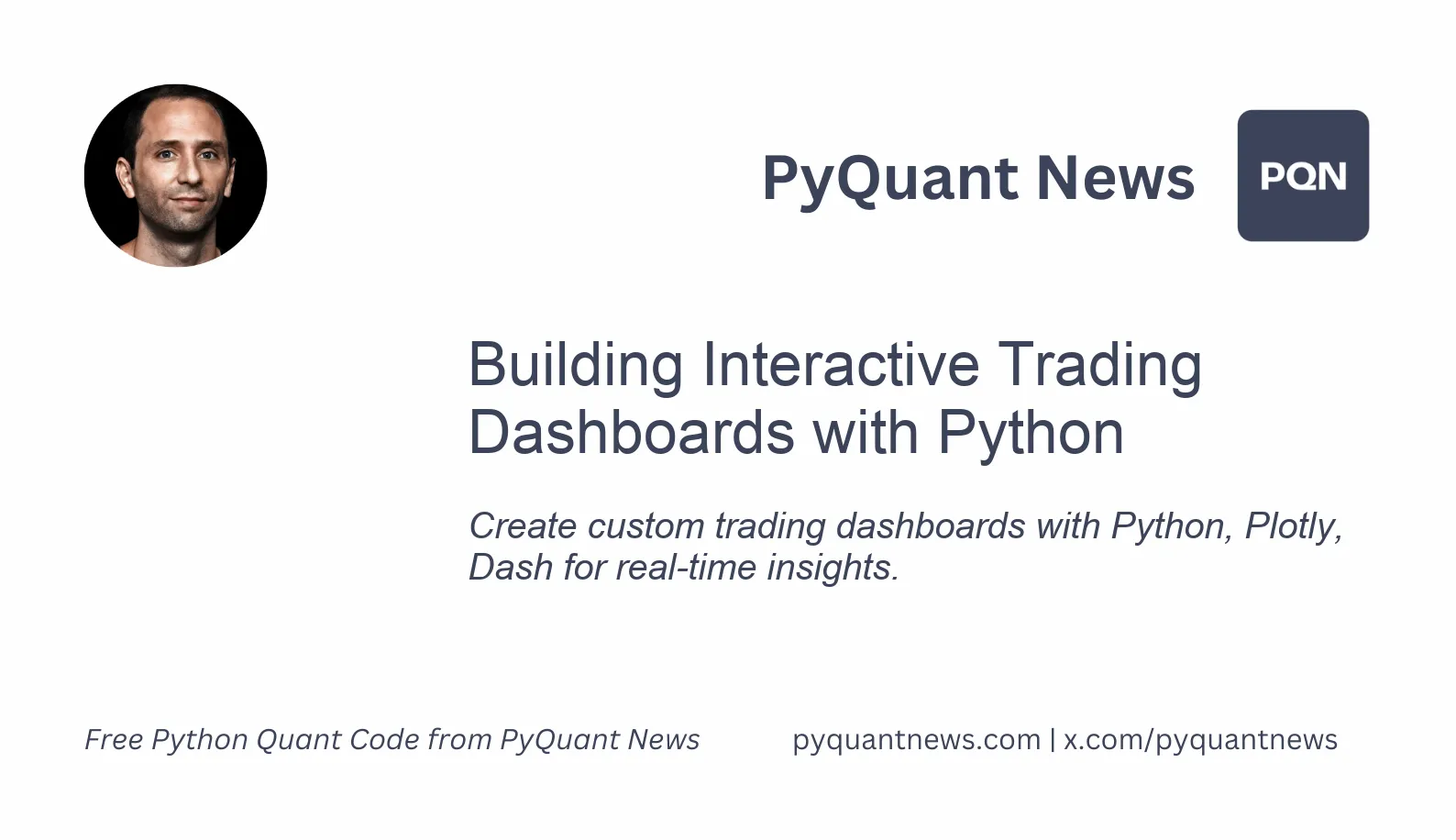Building Interactive Trading Dashboards with Python






Building Interactive Trading Dashboards with Python
In the fast-paced world of trading, analyzing and interpreting data swiftly is key to success. Custom trading dashboards provide traders with real-time market insights, portfolio performance, and risk management tools. Thanks to Python libraries like Plotly and Dash, creating interactive trading dashboards has never been more accessible. This guide explores the steps to develop custom trading dashboards using these powerful libraries, offering a comprehensive roadmap for traders and developers alike.
Introduction to Plotly and Dash
Plotly is a graphing library renowned for its high-quality, interactive visualizations. It supports various chart types, from simple line graphs to complex 3D plots. Dash, built on top of Flask, Plotly, and React.js, is a web application framework that allows users to create interactive, web-based dashboards with minimal coding. The combination of Plotly and Dash is ideal for building custom trading dashboards that are both visually appealing and functionally robust.
Environment Setup: Installing Required Libraries
Before starting the development process, ensure you have Python installed. Then, install the necessary libraries:
pip install plotly dash pandas yfinance
Designing an Intuitive Dashboard Layout
A well-designed layout is important for effective data visualization. The layout should be intuitive, enabling users to easily navigate through different sections and quickly interpret the information. Dash uses a component-based approach, with each part of the dashboard as a customizable component. The primary layout component in Dash is the html.Div().
Here's a basic structure for a trading dashboard:
import dash
import dash_core_components as dcc
import dash_html_components as html
# Initialize the Dash app
app = dash.Dash(__name__)
# Define the layout of the dashboard
app.layout = html.Div([
html.H1("Custom Trading Dashboard"), # Title of the dashboard
dcc.Dropdown(
id='stock-dropdown',
options=[
{'label': 'Apple', 'value': 'AAPL'},
{'label': 'Google', 'value': 'GOOGL'},
{'label': 'Amazon', 'value': 'AMZN'}
],
value='AAPL' # Default selected value
),
dcc.Graph(id='price-chart') # Placeholder for the price chart
])
# Run the app
if __name__ == '__main__':
app.run_server(debug=True)
Fetching and Processing Data
To create meaningful visualizations, you need to fetch and process trading data. The yfinance library is excellent for this purpose, allowing retrieval of historical market data from Yahoo Finance.
import yfinance as yf
import pandas as pd
# Fetch historical market data
def fetch_data(ticker):
stock = yf.Ticker(ticker)
hist = stock.history(period="1y") # Retrieve data for the past year
return hist
Creating Interactive Charts with Plotly
Plotly simplifies the creation of interactive charts. For instance, you can create a time series chart to visualize stock prices over time.
import plotly.graph_objs as go
def create_price_chart(df):
fig = go.Figure()
fig.add_trace(go.Scatter(x=df.index, y=df['Close'], mode='lines', name='Close Price'))
fig.update_layout(title='Stock Price Over Time', xaxis_title='Date', yaxis_title='Price')
return fig
Integrating Data and Visualizations in Dash
Once you have your data and visualizations ready, integrate them into the Dash application. Use callbacks to update charts based on user interactions.
from dash.dependencies import Input, Output
@app.callback(
Output('price-chart', 'figure'),
[Input('stock-dropdown', 'value')]
)
def update_price_chart(ticker):
df = fetch_data(ticker)
fig = create_price_chart(df)
return fig
Enhancing the Dashboard with Additional Features
A robust trading dashboard should offer more than just basic stock price charts. Consider incorporating features like:
- Technical Indicators: Add moving averages and other indicators to provide deeper insights into stock performance.
- Portfolio Management: Include a section to track and analyze your portfolio’s performance.
- News Integration: Display relevant financial news to keep users informed of market-moving events.
- Custom Alerts: Implement alerts for specific conditions, such as a stock reaching a certain price level.
Example: Adding a Moving Average
Here's how to add a moving average to your price chart:
def add_moving_average(df, window):
df[f'MA{window}'] = df['Close'].rolling(window=window).mean()
return df
def create_price_chart_with_ma(df):
fig = go.Figure()
fig.add_trace(go.Scatter(x=df.index, y=df['Close'], mode='lines', name='Close Price'))
fig.add_trace(go.Scatter(x=df.index, y=df[f'MA50'], mode='lines', name='50-Day MA'))
fig.update_layout(title='Stock Price with Moving Average', xaxis_title='Date', yaxis_title='Price')
return fig
@app.callback(
Output('price-chart', 'figure'),
[Input('stock-dropdown', 'value')]
)
def update_price_chart(ticker):
df = fetch_data(ticker)
df = add_moving_average(df, 50)
fig = create_price_chart_with_ma(df)
return fig
Conclusion
Developing custom trading dashboards in Python using Plotly and Dash offers traders a powerful tool for visual performance monitoring. These libraries provide the flexibility to create interactive, data-driven dashboards that deliver real-time market insights and portfolio performance analysis. Whether you are a novice or an experienced developer, Plotly and Dash make it easy to build sophisticated trading tools.
Further Resources
For more information on creating trading dashboards and data visualization, consider exploring these resources:
- Plotly Documentation: Comprehensive guides and examples for various visualizations.
- Dash Documentation: Extensive documentation on building interactive web applications with Dash.
- YFinance Documentation: Detailed information on using the yfinance library to fetch financial data.
- TradingView: Explore technical indicators and charting tools.
- Coursera - Python and Machine Learning for Financial Analysis: A course covering Python programming and machine learning for financial analysis.
By utilizing these resources and following the steps outlined, you can create a custom trading dashboard that caters to your specific needs, enhancing your ability to monitor and respond to market conditions effectively.